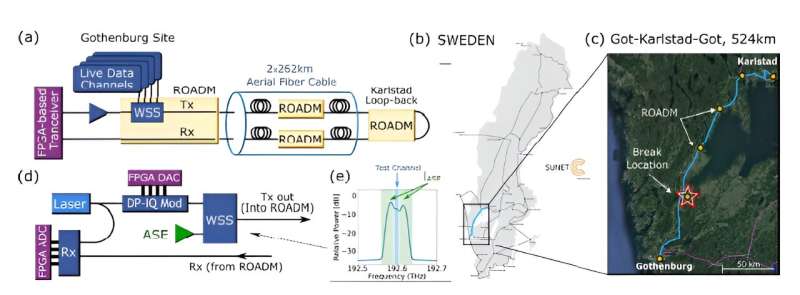
Researchers
have successfully used a coherent transceiver prototype to detect polarization
changes that preceded a cable break in a live network. The work, which is one
of the first demonstrations of field-based measurements for an active cable
break, shows the potential of transceiver-based sensing for actively monitoring
and improving the stability of fiber networks.
Using the global fiber network as a sensor could help improve network robustness and reliability by providing network management and control systems with real-time information about the environment around each fiber path or link. When a significant change is detected, preventative measures could be used to reroute data or to send early warnings that prevent damage to the network.
"We all are exposed and easily frustrated by connectivity disruptions, and protecting the fiber network is therefore of outmost importance," said Mikael Mazur, member of Technical Staff in the Advanced Photonic Research department at Nokia Bell Labs. "Today, our ability to mitigate the effects of fiber breaks are limited due to the lack of sensors capable of monitoring the physical environment in real-time. Without these, network-level management is limited to post outage mitigations rather than taking preventative actions.
"This holds for any outages either caused by human factors such as faulty construction work, and uncontrollable events like bad weather. Our results demonstrate that coherent transceivers with added sensing capabilities can fill this gap, providing a scalable path to implement the smart fiber networks of the future."
Mazur will present this research, which was a collaboration between Nokia Bell Labs US and Chalmers University of Technology and Sunet in Sweden, at OFC, which will take place as a hybrid event 24–28 March 2024 at the San Diego Convention Center.
The researchers used coherent receiver monitoring to perform post-factum analysis of results captured in a live network during a fiber break that occurred when an excavator accidentally exposed the fiber cable during construction. The 524-km link included five reconfigurable optical add-drop multiplexers (ROADMs) and primarily consisted of aerial fiber. The break occurred on a shorter buried segment that connected the ROADM nodes to power line locations.
The fiber was monitored by transmitting a co-propagating signal from a field programmable gate array (FPGA) based coherent transceiver prototype along the live coherent data channels on the network. Baseline measurements showed that most polarization changes occur at frequencies around 1 Hz, matching well with environmental changes.
About 5–7 minutes before the break occurred, higher-frequency content, which reached 50 Hz, was observed. Although the exact cause of this change is unknown, it is likely related to the construction activities that led to the fiber break. The researchers note that the polarization fluctuations observed prior to the break were stronger than any other fluctuations observed during the week-long window before the actual break.
"Studies like these inherently consist of monitoring an uncontrolled real-world environment, and the full complexity entailed, cannot be replicated in labs or simulation environments," said Mazur. "Pushing these features into our coherent transceivers is therefore vital to quickly scale up and enable preventative sensing over the whole optical network. From a research perspective, we are very excited to see these features making their way into products within the near future."

 Previous page
Previous page Back to top
Back to top







